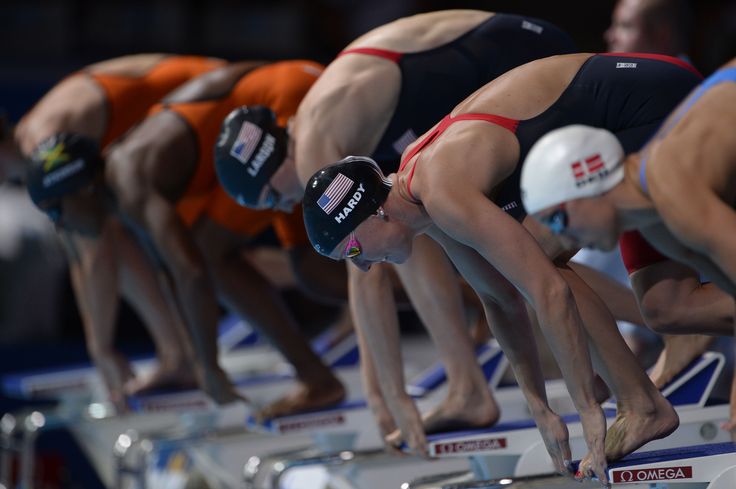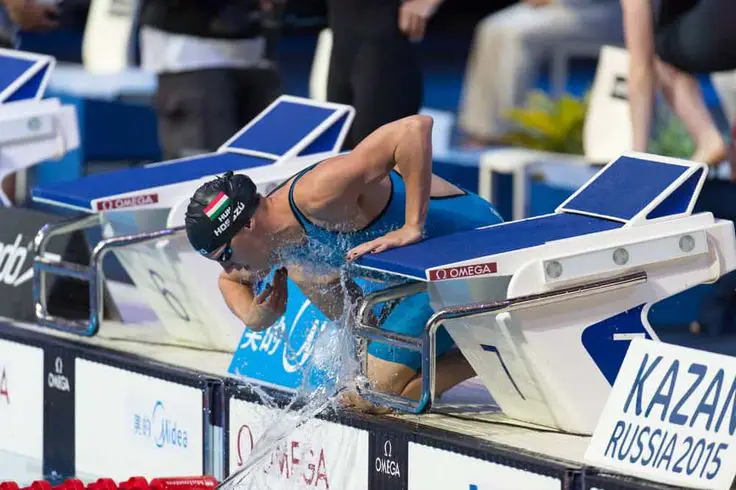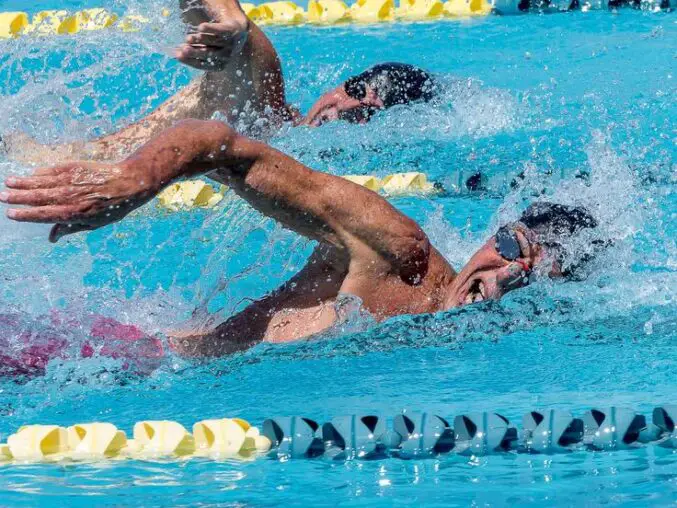
The world of competitive swimming is replete with rituals and practices that might appear bizarre to the uninitiated eye. One such ritual is the pre-race self-slapping, commonly observed among swimmers as they prepare to dive into the pool.
At first glance, it may seem like an unusual and even painful custom. However, this act is deeply rooted in science and holds various physical and psychological benefits for swimmers.
In this article, we will delve into the fascinating world of pre-race slapping, explaining the reasons behind this unique behavior, and exploring how it aids swimmers in their relentless pursuit of victory.
The Puzzling Practice of Pre-Race Slapping
Picture this: a swimmer, moments before their big race, stands by the pool’s edge. With determination in their eyes, they begin rhythmically slapping their arms, thighs, and other muscle groups. To the casual observer, this act might appear perplexing, even painful.
However, swimmers engage in this ritual for a multitude of reasons that contribute to their overall performance. Let’s explore the physical and psychological benefits of this practice, shedding light on why swimmers slap themselves before a race.
The Physical Benefits of Slapping

Enhanced Blood Flow
The act of slapping one’s body stimulates an immediate increase in blood circulation to the targeted areas. Swimmers primarily focus on their arms, legs, and back, areas that play a pivotal role in propelling them through the water.
This rush of blood supplies oxygen and essential nutrients to these muscle groups, ensuring they are primed for peak performance. The heightened blood flow prepares the muscles for the rigorous demands of the impending race.
Muscle Warm-Up
Much like a car engine, muscles function optimally when they are adequately warmed up. Slapping serves as an active stretching technique that accelerates muscle warm-up.
By rhythmically slapping their muscles, swimmers improve flexibility, reducing the risk of muscle strains or injuries. This warm-up routine is essential in ensuring that their muscles are pliable and responsive to the intense physical activity ahead.
Elevation of Core Temperature
Competitive swimming often involves diving into cold pool waters, which can be a shock to the swimmer’s system. The pre-race slapping ritual helps elevate the swimmer’s core temperature slightly.
This rise in body temperature effectively mitigates the impact of the initial cold water immersion, enabling swimmers to maintain high-performance levels right from the start of the race.
Improved Recovery
Beyond preparing swimmers for their races, slapping also facilitates post-race recovery. The increased blood flow carries away lactic acid, which accumulates in the muscles during rigorous exercise like swimming.
This process contributes to a quicker recovery, minimizes muscle soreness, and enables swimmers to remain in top form throughout their competitions.
The Psychological Benefits of Slapping
Intimidation Tactic
Pre-race slapping isn’t just for the swimmer’s physical advantage; it can also serve as an intimidation tactic. Observing a fellow competitor vigorously slapping themselves may sow seeds of doubt in the minds of their opponents.
The deliberate and determined demeanor exhibited through slapping sends a clear message: this swimmer is a force to be reckoned with, unyielding and resolute in their pursuit of victory. Such psychological warfare can provide an additional edge over the competition.
Mental Preparation
Swimming is as much a mental game as it is a physical one. The sound of a resounding slap on the skin acts as a psychological trigger, signaling to swimmers that it’s time to focus and get in the zone.
This act serves as a mental switch that helps them block out distractions and hone their concentration exclusively on the race ahead. The ritualistic nature of slapping creates a structured and focused mindset, ensuring swimmers are mentally prepared for the challenges that lie ahead.
Stress Reduction
The world of competitive swimming can be an exceedingly stressful one. The pressure to perform, the anticipation of the race, and the presence of an expectant audience can all contribute to heightened stress levels.
Engaging in a pre-race slapping ritual helps mitigate this stress. The physical act of slapping triggers the release of endorphins, the body’s natural painkillers and ‘feel-good’ chemicals.
This phenomenon reduces anxiety and enhances mood, leaving swimmers feeling more relaxed and confident as they approach the starting block. In essence, pre-race slapping becomes a crucial stress management tool for competitive swimmers.
Swimmers are known for their meticulous preparation, discipline, and dedication to their craft. The act of pre-race slapping is a testament to their unwavering commitment to their sport.
To those unfamiliar with the intricacies of swimming, it might seem like an eccentric and peculiar practice, but in reality, it is a manifestation of the deep understanding swimmers have of their bodies and minds.
This ritualistic behavior is a vital component of their pre-race routine, contributing to their success in the pool.
A Symphony of Slaps: The Synchronized Dance of Swimmers
Now that we’ve demystified the reasons behind swimmers’ pre-race slapping ritual, it’s important to recognize that this act is not an individual endeavor but a collective phenomenon. Before a race, the pool area becomes a theater of rhythmic and synchronized slapping, akin to a prelude before the main performance.
Swimmers, often belonging to the same team or sharing camaraderie through their shared love for the sport, engage in this ritual as a collective expression of focus and unity.
As they stand together, each swimmer slapping in harmony, a sense of shared purpose permeates the air. The symphony of slaps becomes a prelude to the symphony of strokes that will soon echo through the water.
This unifying ritual represents the shared journey of swimmers, each with their unique aspirations and goals, coming together for a common pursuit of excellence in the sport they cherish.
Understanding the Scientific Rationale Behind Swimmer’s Slap

The pre-race slapping ritual isn’t merely a random or superstitious practice. Instead, it is a calculated and scientifically grounded approach to preparing the body for the rigors of competitive swimming.
This discipline hinges on principles that are well-supported by scientific research. By slapping specific muscle groups and areas of their body, swimmers set into motion a cascade of physiological responses that enhance their performance and ensure they are race-ready.
Let’s explore these principles in detail:
The Science of Blood Flow Stimulation
Slapping one’s body triggers a physiological response: an immediate increase in blood flow to the targeted areas. As the skin reddens in response to the slap, it signifies enhanced circulation in that region.
This surge of blood carries with it a fresh supply of oxygen and nutrients, critical for optimal muscle function. The significance of this response cannot be understated for swimmers, as their performance hinges on the efficient delivery of oxygen to their hard-working muscles.
Swimmers often concentrate their slapping on their arms, thighs, and backs, recognizing these muscle groups as central to their swimming strokes.
The enhanced blood flow readies these areas for the demanding physical exertion they are about to undertake. With an ample supply of oxygen and nutrients, these muscle groups become less susceptible to fatigue and injury, setting the stage for peak performance in the pool.
The Warm-Up Effect
The human body, like any well-engineered machine, requires proper warming up to function optimally. Muscles are no exception to this rule; they function best when they are warm and flexible. Slapping serves as a rapid and effective means of warming up muscles.
The percussive nature of slapping initiates a gentle yet potent awakening of the muscle fibers. The heat generated as a result of this process increases muscle elasticity, reducing the risk of strains or injuries.
As swimmers embark on intense and strenuous workouts, having their muscles warmed up and primed for action is critical. Slapping provides the necessary stimulus for muscle readiness, ensuring that the first stroke they take is powerful and efficient.
Managing Core Temperature
Competitive swimming often entails plunging into cold pool waters, a chilling experience that can be mentally and physically daunting. The ritualistic practice of slapping plays a vital role in managing swimmers’ core temperatures.
By elevating the body’s temperature slightly, it serves as a buffer against the initial shock of the cold water. This small yet significant increase in core temperature enables swimmers to maintain a high level of performance right from the moment they enter the water.
Accelerating Recovery
The increase in blood flow that results from the rhythmic slapping of the skin also has an essential role to play post-race. Following an intense swim, swimmers often experience a buildup of lactic acid in their muscles, leading to soreness and fatigue.
Slapping, with its associated boost in circulation, assists in the removal of this lactic acid. The result is a quicker recovery process, ensuring that swimmers remain in top form throughout the duration of their races, without succumbing to muscle soreness.
The Intricate Dance of Swimmers: Collective Slapping
Beyond its individual benefits, pre-race slapping takes on a more profound dimension when viewed as a collective endeavor. Before a race, the pool area undergoes a transformation as swimmers from the same team or those bonded by the shared love of the sport come together.
Standing side by side, they engage in this rhythmic and synchronized ritual. The unison of slaps resonates as a prelude to the grand performance that is about to unfold in the water.
The synchronized slapping of swimmers represents their unity and shared purpose. Each athlete, with their unique aspirations and dreams, stands together with their peers, expressing their unwavering commitment to the sport of swimming.
This communal ritual creates an atmosphere of camaraderie and togetherness, reinforcing the sense of belonging and shared determination that defines the world of competitive swimming.
Conclusion
Swimming, a sport that demands unwavering discipline and physical prowess, often conceals its rituals and practices from the casual observer. The pre-race slapping ritual, an intriguing aspect of competitive swimming, has been unveiled in this exploration.
Understanding the physical and psychological benefits of this act offers an appreciation of the dedication and preparation that swimmers bring to their craft.








